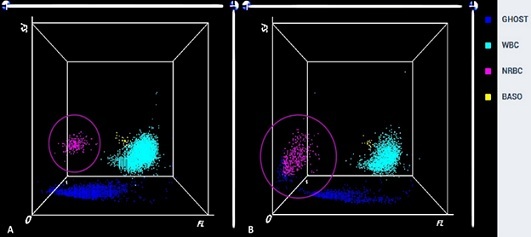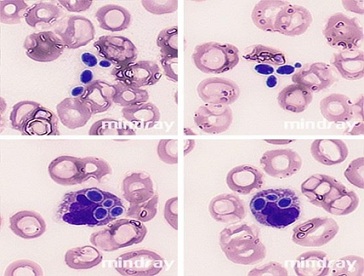
The Critical Role of the Complete Blood Count in the Diagnosis of Candidemia: A Case Report
*Corresponding Author(s):
Valentina ZanottiDepartment Of Health Sciences, Amedeo Avogadro University Of Eastern Piedmont, Novara, Italy, Clinical Chemistry Laboratory, Maggiore Della Carità Hospital, Novara, Italy
Tel:+39 3475190546,
Email:valentina.zanotti@uniupo.it
Abstract
A 74-year-old woman with a complex medical history developed unexplained hyperthermia after surgery. An abnormal blood scattergram led to the discovery of rare ovoid structures in the peripheral blood smear, raising suspicion of candidemia and emphasizing the critical role of blood count and laboratory specialists in the clinical diagnostic process.
Keywords
Blood count; Candidemia; Nucleated blood cells; Scattergram; Spores
Case Report
A 74-year-old woman with a cephalo-duodeno-pancreatectomy complicated by a resection dilatation, a stoma and a decubitus ulcer with a port-a-cath for parenteral therapy was admitted to the Department of Internal Medicine of the Maggiore della Carità University Hospital, Novara, Italy, with short bowel syndrome. The woman was diagnosed with Clostridium difficile colitis and treated with antibiotic therapy. In the days following hospitalization, the patient showed unexplained hyperthermia.
The complete blood count showed a WBC count of 4140/microL, neutrophils 70.5%, lymphocytes 15.7%, monocytes 10.1%, eosinophils 3%, basophils 0.7%, hemoglobin 8.7 g/dL, platelets 51000/microL and 16.39% nucleated red blood cells (NRBC). However, analysis of the WNB scatterplot revealed that the erythroblast population (purple color code in the figure) was in an anomalous position: a left shift compared to the usual position of the NRBC cluster (Figure 1).
Due to the anomalous distribution of the erythroblast population in the WNB scattergram, we decided to proceed with the microscopic review of the peripheral blood smear (SC-120 Mindray, Medical Systems) analyzed with the MC 80 (Mindray, Medical Systems).

Figure 1: (A) In WNB scattergram (WNB channel), the BC-6800 Plus provides distinct cluster for the nucleated red blood cells (NRBC), in a specific position (Mindray, Medical Systems). (B) Position cluster of NRBC in our patient.
The microscopic analysis did not confirm the presence of NRBC. On the other hand, in different areas of the analyzed blood smear, some ovoid blue-purple bodies, free in the plasma, and others enclosed, visible in the cytoplasm of neutrophils, were observed. Some spores were in small groups (3-4 elements) and some with buds (Figure 2). These inclusions were probably mistaken for NRBCs by the analyzer. So far, no similar case has been described in the literature.
Therefore, a diagnostic examination was recommended by the laboratory in case of suspected candidemia.

Figure 2: This is a caption of free spores and spores included by neutrophils (MC-80 Mindray, Medical Systems).
Bacteriologic examination revealed positivity for Candida glabrata (C. krus-glab).
Candidemia usually causes fever but no specific symptoms. Some patients, as in our case, develop a syndrome like bacterial sepsis, in some cases with a fulminant course that may include shock, oliguria, and renal failure and disseminated intravascular coagulation. Most infections are caused by C. albicans, but C. glabrata and other non-albicans species are increasingly implicated in fungal infections and other focal disease. Neutropenic patients have a high risk of developing disseminated candidiasis [1]. Non-neutropenic patients may develop candidemia during prolonged hospitalization, and such bloodstream infection is often associated with central venous catheters, major surgery, and broad-spectrum antibacterial therapy [2]. All forms of disseminated candidiasis should be considered serious, progressive and potentially fatal [3].
Conclusion
The present case demonstrates the importance of careful analysis of blood count scattergrams to detect cellular abnormalities, to identify potentially pathologic specimens, and to examine them microscopically. The laboratory specialist plays an important and crucial role in the diagnostic process and is an essential and indispensable element in the clinical diagnostic process.
References
- Sung-Yeon C, Hyojin C, Myungshin K, Dong-Gun L, Hee-Je K (2016) Budding Yeast Cells in Peripheral Blood Smear: Clue to Candidemia. Infect Chemother. 48: 342-343.
- Selay L, Cyrus CH (2012) Peripheral blood Blood. 119: 4822.
- Hirai Y, Asahata S, Ainoda Y, Fujita T, Miura H, et al. (2015) Candidemia Diagnosed from Peripheral Blood Smear: Case Report and Review of Literature 1954-2013. 180: 111-116.
Citation: Zanotti V, Sacchetti S, Giacomini L, Dianzani U, Rolla R (2024) The Critical Role of the Complete Blood Count in the Diagnosis of Candidemia: A Case Report. J Clin Stud Med Case Rep 11:228
Copyright: © 2024 Valentina Zanotti, et al. This is an open-access article distributed under the terms of the Creative Commons Attribution License, which permits unrestricted use, distribution, and reproduction in any medium, provided the original author and source are credited.

